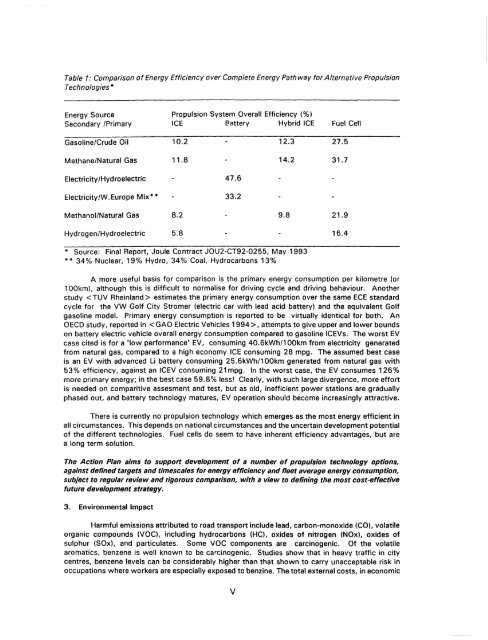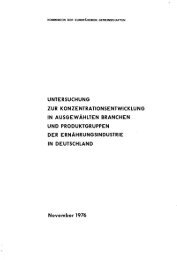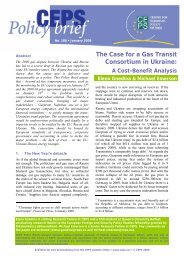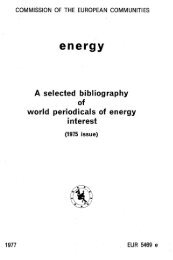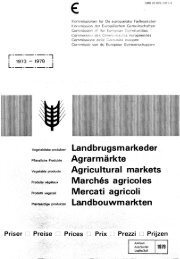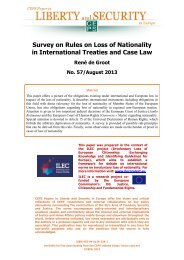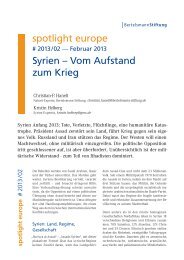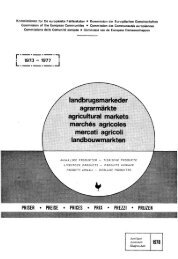Download (1447Kb) - Archive of European Integration
Download (1447Kb) - Archive of European Integration
Download (1447Kb) - Archive of European Integration
You also want an ePaper? Increase the reach of your titles
YUMPU automatically turns print PDFs into web optimized ePapers that Google loves.
Table 1: Comparison <strong>of</strong> Energy Efficiency over Complete Energy Pathway for Alternative Propulsion<br />
Technologies*<br />
Energy Source<br />
Secondary /Primary<br />
Gasoline/Crude Oil<br />
Methane/Natural Gas<br />
Electricity /Hydroelectric<br />
Electricity/W.Europe Mix**<br />
Methanol/Natural Gas<br />
Hydrogen/Hydroelectric<br />
Propulsion System Overall Efficiency (%)<br />
ICE Battery Hybrid ICE<br />
10.2 12.3<br />
11.8 14.2<br />
47.6<br />
33.2<br />
8.2 9.8<br />
5.8<br />
Fuel Cell<br />
27.5<br />
31.7<br />
21.9<br />
16.4<br />
• Source: Final Report, Joule Contract JOU2-CT92-0255, May 1993<br />
• • 34% Nuclear, 19% Hydro, 34% Coal, Hydrocarbons 13%<br />
A more useful basis for comparison is the primary energy consumption per kilometre (or<br />
1 OOkm), although this is difficult to normalise for driving cycle and driving behaviour. Another<br />
study < TUV Rheinland> estimates the primary energy consumption over the same ECE standard<br />
cycle for the VW Golf City Stromer (electric car with lead acid battery) and the equivalent Golf<br />
gasoline model. Primary energy consumption is reported to be virtually identical for both. An<br />
OECD study, reported in , attempts to give upper and lower bounds<br />
on battery electric vehicle overall energy consumption compared to gasoline ICEVs. The worst EV<br />
case cited is for a 'low performance' EV, consuming 40.6kWh/1 OOkm from electricity generated<br />
from natural gas, compared to a high economy ICE consuming 28 mpg. The assumed best case<br />
is an EV with advanced Li battery consuming 25.6kWh/1 OOkm generated from natural gas with<br />
53% efficiency, against an ICEV consuming 21 mpg. In the worst case, the EV consumes 126%<br />
more primary energy; in the best case 59.8% less! Clearly, with such large divergence, more effort<br />
is needed on comparitive assesment and test, but as old, inefficient power stations are gradually<br />
phased out, and battery technology matures, EV operation should become increasingly attractive.<br />
There is currently no propulsion technology which emerges as the most energy efficient in<br />
all circumstances. This depends on national circumstances and the uncertain development potential<br />
<strong>of</strong> the different technologies. Fuel cells do seem to have inherent efficiency advantages, but are<br />
a long term solution.<br />
The Action Plan aims to support development <strong>of</strong> a number <strong>of</strong> propulsion technology options,<br />
against defined targets and timescales for energy efficiency and fleet average energy consumption,<br />
subject to regular review and rigorous comparison, with a view to defining the most cost-effective<br />
future development strategy.<br />
3. Environmental Impact<br />
Harmful emissions attributed to road transport include lead, carbon-monoxide (CO), volatile<br />
organic compounds (VOC), including hydrocarbons (HC), oxides <strong>of</strong> nitrogen (NOx), oxides <strong>of</strong><br />
sulphur (SOx}, and particulates. Some VOC components are carcinogenic. Of the volatile<br />
aromatics, benzene is well known to be carcinogenic. Studies show that in heavy traffic in city<br />
centres, benzene levels can be considerably higher than that shown to carry unacceptable risk in<br />
occupations where workers are especially exposed to benzine. The total external costs, in economic<br />
v


